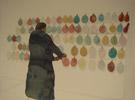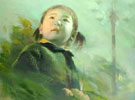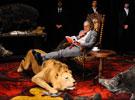Affairs to Remember – Installations by James Chu
A Macao luminary, James Chu has multiple identities: he is an artist, designer, curator and Chairman of the General Assemble of AFA. He is also involved in filmmaking and acting. He has achieved much in each of these areas. Regarding design and artistic creation, he is the recipient of more than 30 awards, many of which are international. All this stems from his passion for art and work. From being a designer, to his work as artist and a curator, these transformations reflect the development of modern art in Macao. As an artist, James Chu enriches his art with diverse themes and genres, including painting, photography, sculpture and installation. He is not bound by conventional concepts but seeks to explore and experiment to the greatest extent, and with new artistic styles and media.
The exhibition entitled “Affairs to Remember”, organised in AFA Beijing, is divided into themes: “The 911 Series”, “Changes in Macao”, and “Intrusion”. These are mostly installation artworks. This year marks the 10th anniversary of the 911 attack, and “The 911 Series” was created to commemorate the disaster and to pay homage to the victims. Just twelve days prior to the attack in 2001, James Chu stepped into New York City for the first time to see the city’s landmark twin towers of the World Trade Centre. Upon returning to Macao, he witnessed on television the 911 attack that shook the world. The thoughts he had at that time were the genesis of this series. From its creation to exhibition, the work took a difficult decade. Indeed, there were many opportunities to display the work over those ten years but, for various reasons, nothing came of these plans. The work seemed to incubate for an entire decade to form, at the end of this process, a work that is both striking and profound.
“The 911 Series” is composed of four works: “Burning of Incense”, “Lister to the Wind”, “Mercy” and “An Affair to Remember”. “Burning of Incense” uses two giant burning incense sticks to symbolise the twin towers of the World Trade Centre. Over the course of the exhibition, the artist restages, in slow motion, the moment the famous buildings collapsed. It embodies the unique expression of the artist, who ingeniously combines the round altar of a western church with the Chinese sacrificial offering of burning incense. This seems to be a casual setting but reflects the artist1s purest and most sincere humanity and emotional care. For some people, a decade is a long time. Some happenings leave an indelible mark in life while other moments, as plain as a glass of water, are forgotten easily. However, a decade is barely a blink in the entire life of mankind. Although some events occur in just a moment, they will be remembered forever and never fade from the long river of history. Like those who have lost their lives and families who lost loved ones in the 911 attack, their grief and loss will remain a pain in human history. A similar work, “Listen to the Wind”, commemorates the attack and pays homage to the dead using 2,977 small bells to symbolise the 2,977 victims of the 911 attack.
Human beings are the creators of history and development. In “Five-storey Mansions”, the artist tells viewers a truth through his personal feeling and experience. Even when we participate in the development of the city, and however eager we are to keep these feelings or memories, the wheel of history always rolls forward powerfully and with dynamic force. When we look back on the city that was once familiar, it is beyond recognition. This work is composed of twelve photos depicting various five-storey mansions in different districts of Macao. They are placed on a special rotating device. As the device rotates in the lighting effects, the reflection on the wall is virtual but real, bringing viewers back to 1970s and 1980s Macao, or the old street settings in the movies by Johnny To Kei Fung or Ann Hui On Wah.
In his narration, the artist once said that “the relationship between people and people, between neighbours and neighbours has become alienated. There were children playing kites or riding bicycles after school on the rooftops of buildings in the past, but this is no longer seen. Next to these 20-meter “Five-Storey Mansions” are a number of high rise buildings as tall as 200 meters (aviation control height in Macao), and what a spectacular contrast is formed. The appearance of Macao is constantly changing, and it is hard to tell what is beautiful and what is ugly.” Many people may have the same feeling. Although residential buildings are increasingly beautiful, and life has improved in many ways, the gap between people is widening.
Art and life are continuous aspects of aesthetics. The third theme of this exhibition is a perfect embodiment of this. Against conventional practice, the artist expresses and participates in art in the form of living. “A Short Ride”, video installation work, was composed by James Chua in Shanghai in 2008 at the invitation of the Shanghai Zendai Museum of Modern Art. The artist hired a taxi and solicited people on the street. He introduced the project and its purpose to passengers and delivered them to the destinations for free if passengers agreed to get into the taxi. During the ride, the artist participated in daily conversation with passengers and took pictures with them upon arrival. At the same time, two cameras were installed inside the taxi to capture these moments. During the recording, the artist met many different people with various jobs, including local workers, retired people, bosses, foreign workers, and artist assistants, and their conversation and behaviour deeply affected the artist.
The last work, “Washing Legs in Macau”, is an interpretation of a common expression in Cantonese, "washing legs but not drying them”, and explores the profligacy of people in today’s Macao. This work was displayed at He Xiang Ning Art Museum in Shenzhen in 2010 in an exhibition called “The Butterfly Effect – An Artistic Communication Project of Cross-Strait Four-Regions” developed by experienced curator Feng Boyi. In “Washing Legs in Macau”, the artist made a model using his legs, and placed the model on a basin full of water from Macao. The entire work is then placed in a white cylinder and can only be viewed via a door viewer, creating an illusion for viewers that they are washing their own feet.
If we view time as the ordinate and its process as the abscissa, the points which appear on the coordinate graph can be seen as events and the lines connecting the points represent life experiences. The points or lines represent the ups and downs in this domain. Compared to significant historical events, the individual often may think they are puny or insignificant. But as William Blake said, “To see a world in a grain of sand and a heaven in a wild flower” is to discover some infinite eternal truths that often originate from small events and personal experience, but which also reflect historical change. In James Chu’s exhibition “Affairs to Remember”, the pieces of memory reflected in his work tell us eternal truths of mankind: love and mercy.




